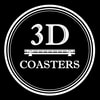Launching
April 2021 - August 2022
|
|
Launching Specs:
1:35 scale Track Gauge: 26mm Track Length: 8.05m Length: 2.4m Width: 0.3m Height: 0.7m Number of components: 3202
Design Time: ~700h Print Time: ~1200h Post Processing Time: ~40h Assembly Time: ~50h Printer: Prusa MK3S+ Nozzle Diameter: 0.3mm |
|
After the success of the first functioning layout, a longer ride with more unconventional and extreme elements was developed over multiple iterations in NoLimits2.
When finalized, coordinates of the track points were exported and then brought into Fusion 360 for 3D modeling.
|
|
A rail and spine profile were sketched and swept along the length of the imported spline. This provided the groundwork for modeling the rest of the track details and supports. Each column was custom designed to hold up the track in areas of high stress and in some locations, was able to support multiple pieces with a single support section.
The above images visualize the progression from imported spline to modeled track and supports that were able to be exported as .stl files and 3D printed.
From the sliced 3D models, columns, flanges, track ties, and track spines were printed independently to allow for a cleaner final appearance of the structures. This added a considerable amount of assembly time, but paid off in overall print quality and final detail.
A more in depth look at track and support construction can be seen in the prototype track sections that were developed prior to this layout in order to solidify design decisions and streamline the modeling workflow.
|
|
Supports:
Each column and track spine was sanded thoroughly to ensure a smooth surface finish prior to painting and final assembly. A total of 36 support assemblies with 108 custom columns brace the track at 44 locations along its length.
The flanges, columns, footers, and accompanying rods and hardware account for nearly 600 of the overall parts that make up the layout.
|
Track:
The track is comprised of 40 sections, each averaging 24 individual components. Overall, a total of 401 ties, 78 spines, 270 spine standoffs, 56 headplates, and 84 track-column Y reinforcements were printed. In addition, 71 M2 screws were used to secure both track to track and track to column connections. All in all, the track sections alone accounted for nearly 1000 of the parts used in the build.
The track is comprised of 40 sections, each averaging 24 individual components. Overall, a total of 401 ties, 78 spines, 270 spine standoffs, 56 headplates, and 84 track-column Y reinforcements were printed. In addition, 71 M2 screws were used to secure both track to track and track to column connections. All in all, the track sections alone accounted for nearly 1000 of the parts used in the build.
|
|
4mm OD PTFE tubing was used as rail again to provide a seamless and smooth running surface for the train. To attach to the track, a jig holding 2 razor blades was used to slice out a section of the tube for the crossties to snap into.
If you'd like to try your hand at building your own coaster, you can find the .stl of the tube slicer via the link below:
|
|
The entire gravity section of the layout was dry-fit to ensure all supports and track sections aligned properly prior to painting.
To accomplish this, thru holes were first drilled into a plywood board with a printed footer layout and M3 hardware was used to fasten the footers and base supports.
|
|
After verifying clearances with a prototype train, the entire layout was disassembled and the track and supports were painted dark blue and silver.
Following the construction of the gravity section, the more advanced mechanical assemblies of the launch, transfer track, and station were designed and printed. Their individual build processes can be seen via the links below:
After all subassemblies were printed, painted, and evaluated, final assembly came next and was documented in the following video:
After many hours of troubleshooting and testing with both single and multiple trains, the project was at last completed.
Some final still photos were taken of the trains navigating various elements on the layout. For a more in depth look at their construction, follow the link below:















